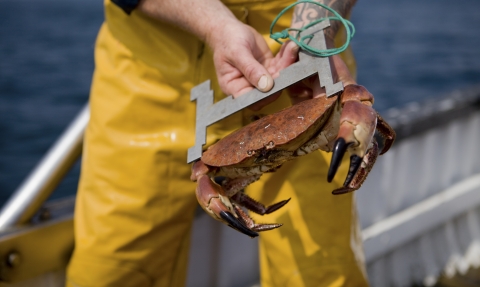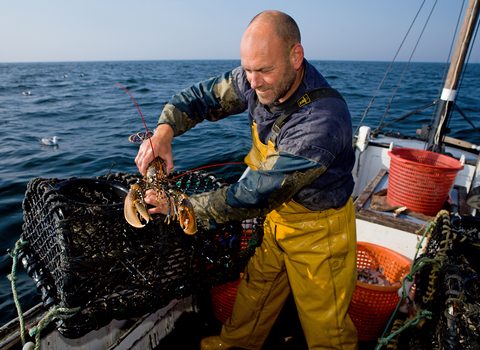
Shore crab being measured © Toby Roxburgh/2020VISION
Great Solent Seafood Species
When it comes to sustainable seafood, the picture is a complex one. The health of seafood species and their habitats is affected by lots of different factors, and 'sustainability' can be hard to define.
Just as certifications like 'organic' and 'free-range' are now common for fruit, vegetables, meat, and dairy, you can see phrases like 'responsibly sourced' or a blue tick on fish and shellfish. But what does sustainable seafood actually mean for our local waters?
The Solent is both a vibrant space for wildlife and one of the busiest waterways in Europe. Thousands of people interact with it each day and want to help protect its special qualities, whether that's beautiful coastlines, great conditions for sailing, or the means to make a living.
Through our Great Solent Seafood campaign we're delving into the complexities of fishing in our region. We're examining the factors affecting our edible species and the people who catch them, and highlighting some more sustainable options.
How our species are chosen
While no seafood is currently 100% sustainable, some choices are a much bigger step in the right direction. We recommend certain species based on several sustainability factors, so as the situation changes our recommendations might too.
Where are they caught?
In the UK we export most of the seafood we catch and import most of the seafood we eat. This exchange produces carbon emissions and makes it harder to know the environmental standard of what ends up on our plates.
Many local suppliers want to support more sustainable methods, but the low level of local demand makes it difficult to do so. Greater demand for local seafood, caught in a sustainable way, could address this issue and further encourage local communities to value our seas.
Our recommended species are caught within or just outside of the Solent, and can be bought within Hampshire or the Isle of Wight.
How are they caught?
Some fishing methods, especially 'bottom-towed' ones that pull gear along the seabed, can damage important marine habitats. Rock reefs, maerl beds, and seagrass beds are hugely precious for wildlife, currently under threat, and especially vulnerable to these types of gear.
Some methods and gear also have a higher chance of catching unwanted species, or juveniles of target species - these animals are known as bycatch. Marine birds and mammals that get entangled are also sometimes included in this category.
Bycatch is an issue because many of the animals don't survive, even if returned to the water. Losing juveniles of any species, including target ones, makes it harder for their populations to remain stable. A drop in these populations can also affect the food chain, impacting a number of other species.
Our recommended species are caught using either lower-impact methods or higher-impact methods that are limited by management measures. For example, local bylaws ban the use of bottom-towed gear in some areas, and new legislation on net mesh size and discarding of unwanted species should help to tackle bycatch.
Are their populations stable?
The populations of commercially-fished species must be carefully monitored to ensure they remain stable. Fisheries managers do regular reviews called 'stock assessments' to work out how many of their target species can safely be caught.
Commercially-fished species that are fished at a level called Maximum Sustainable Yield should be able to recover their numbers. If they're fished below this limit then they should be able to increase their numbers over time.
Some fisheries also have a 'closed season', which often coincides with the breeding season of target species, so that their populations and habitats can recover. This means that commercially-fished species can have two kinds of seasonality: when they're present in our waters, and when they're available for purchase.
Our recommended species are classified as having relatively stable populations by the Marine Conservation Society and the Southern Inshore Fisheries and Conservation Authority. They'll also be new to some people, which is important because diversifying our diets reduces the pressure on the target species.
Are their fisheries well-managed?
Rules and regulations
There are many laws that govern the management of fisheries, which are intended to ensure that they're operating responsibly. These are hugely important for sustainability because illegal, unreported and unregulated fishing can pose a significant threat to our wildlife.
For years the Common Fisheries Policy shaped the bulk of fisheries management in the UK, but this will change as we leave the European Union. We already have exclusive control of our inshore fisheries (within six nautical miles of shore) but will now have more influence out to the limits of our territorial waters – our Exclusive Economic Zone.
Fishers themselves have differing views of fisheries management and how it's carried out, but all want stable populations of their target species. It's vital that fishers, managers, and conservationists engage with each other to ensure the regulations are ambitious but also realistic.
Enforcement
Inshore fisheries in our region are managed by the Southern Inshore Fisheries and Conservation Authority (SIFCA). Its fisheries managers have limited resources and mostly rely on an in-depth understanding of their area. These managers issue verbal warnings, official warnings, and fines, with some cases going to court.
Our recommended species are from fisheries which have good management in place. We've worked with the SIFCA for many years, and continue to provide data to help put in place effective measures for protecting our wildlife.

© Toby Roxburgh
Sustainability FAQs
Read our answers to common questions about fishing and sustainability.
